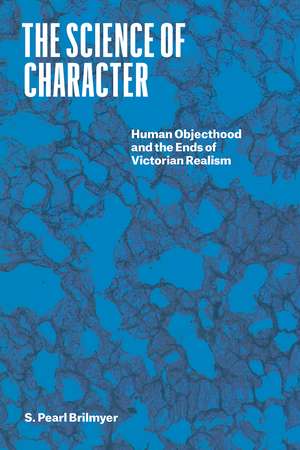The Science of Character: Human Objecthood and the Ends of Victorian Realism: Thinking Literature
Autor Professor S. Pearl Brilmyeren Limba Engleză Paperback – 11 ian 2022
In 1843, the Victorian philosopher John Stuart Mill called for the establishment of a new science, “the science of the formation of character.” Although Mill’s proposal failed as scientific practice, S. Pearl Brilmyer maintains that it found its true home in realist fiction of the period, which employed the literary figure of character to investigate the nature of embodied experience. Bringing to life Mill’s unrealized dream of a science of character, novelists such as George Eliot, Thomas Hardy, and Olive Schreiner turned to narrative to explore how traits and behaviors in organisms emerge and develop, and how aesthetic features—shapes, colors, and gestures—come to take on cultural meaning through certain categories, such as race and sex. Engaged with materialist science and philosophy, these authors transformed character from the liberal notion of the inner truth of an individual into a materially determined figuration produced through shifts in the boundaries between the body’s inside and outside. In their hands, Brilmyer argues, literature became a science, not in the sense that its claims were falsifiable or even systematically articulated, but in its commitment to uncovering, through a fictional staging of realistic events, the laws governing physical and affective life. The Science of Character redraws late Victorian literary history to show how women and feminist novelists pushed realism to its aesthetic and philosophical limits in the crucial span between 1870 and 1920.
| Toate formatele și edițiile | Preț | Express |
|---|---|---|
| Paperback (1) | 207.35 lei 3-5 săpt. | +14.12 lei 6-10 zile |
| University of Chicago Press – 11 ian 2022 | 207.35 lei 3-5 săpt. | +14.12 lei 6-10 zile |
| Hardback (1) | 666.54 lei 6-8 săpt. | |
| University of Chicago Press – 18 ian 2022 | 666.54 lei 6-8 săpt. |
Preț: 207.35 lei
Nou
Puncte Express: 311
Preț estimativ în valută:
39.68€ • 43.09$ • 33.33£
39.68€ • 43.09$ • 33.33£
Carte disponibilă
Livrare economică 02-16 aprilie
Livrare express 18-22 martie pentru 24.11 lei
Preluare comenzi: 021 569.72.76
Specificații
ISBN-13: 9780226815787
ISBN-10: 0226815781
Pagini: 304
Ilustrații: 5 halftones
Dimensiuni: 152 x 229 x 23 mm
Greutate: 0.37 kg
Editura: University of Chicago Press
Colecția University of Chicago Press
Seria Thinking Literature
ISBN-10: 0226815781
Pagini: 304
Ilustrații: 5 halftones
Dimensiuni: 152 x 229 x 23 mm
Greutate: 0.37 kg
Editura: University of Chicago Press
Colecția University of Chicago Press
Seria Thinking Literature
Notă biografică
S. Pearl Brilmyer is assistant professor of English and comparative literature at the University of Pennsylvania.
Recenzii
"With an acute ear for the references that give metaphors their edge, as in Eliot's unforgettable image of a squirrel’s heartbeat as a figure for that which we cannot bear to know, Brilmyer brings the soaringly evocative back to earth, giving us a new science of literary analysis."
“Brilmyer’s book shows how the realist imperative to adequately describe the relation between characters and their circumstances unwound Victorian Realism from within, as new scientific theories of matter, force, and cellular life led high Victorian realists— such as George Eliot and Thomas Hardy—and a subsequent generation of New Woman novelists to press the form to its limits and beyond. A major new study of literary character, The Science of Character is important not least for the way it revises the literary history of Victorian Realism and its ends.”
“Brilmyer’s work marks a new epoch in the study of realism. Developing out of deep historical research and an engagement of the thinking of philosophers, theorists, and scholars of character, Brilmyer reverses dominant understandings of the way late nineteenth-century fiction developed to trace the emergence of an impersonal dynamic materialism that from George Eliot forward reimagined the nature of character itself. This is an extraordinarily original and important contribution, both to the history of realism and the novel and to new theorizing about matter.”
“The Science of Character brilliantly and boldly renews discussions of the late Victorian history of the novel. Brilmyer shows us how figures such as George Eliot, Thomas Hardy, and Olive Schreiner revised the definition of a realistic character along new, materialist lines. That revision demonstrated literature’s ability to produce insights into the workings of both nature and culture.”
“Character: a slippery term that can denote either a human-like entity in a literary text or the specific assemblage of traits that makes one person different from others. In this beautifully argued book, S. Pearl Brilmyer refuses to choose between these two possibilities. Instead, she shows how novelists at the end of the nineteenth century enlisted the former in the service of discovering the workings of the latter—how, that is, George Eliot, Sarah Grand, Olive Schreiner, George Gissing, and Thomas Hardy transformed their aesthetic practice into a science of character. Turning the study of literature and science on its head by demonstrating the degree to which the production of literature was a scientific endeavor for these writers, she also formulates a unified field theory of the late-nineteenth-century novel that recognizes the centrality of women writers and finds in New Woman fiction the key to that novel’s theorization of character and circumstance as inseparable. Bracingly rigorous, intellectually thrilling, exhaustively researched, with far-reaching consequences for our understanding of the novel: The Science of Character is a remarkable achievement.”
“The Science of Character is learned and continuously intelligent, a model of philosophically informed criticism. Brilmyer makes a theoretical advance in the conceptualization of character, realism, and the novel itself. This book provides a rigorous proof of concept for feminist New Materialism, and deepens our understanding of several canonical writers. The Science of Character redraws late-century Victorian literary history.”














